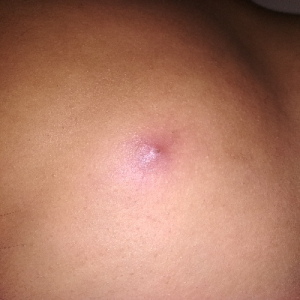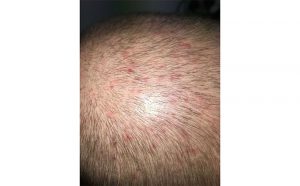Folliculitis
Folliculitis is a common skin condition in which hair follicles become inflamed. It’s usually caused by a bacterial or fungal infection. At first it may look like small red bumps or white-headed pimples around hair follicles. The tiny pockets from which each hair grows. The infection can spread and turn into non-healing, crusty sores.
The condition isn’t life-threatening, but it can be itchy, sore and embarrassing. Severe infections can cause permanent hair loss and scarring.

In mild case, a few days with basic self-care measures can take. In more serious or recurring folliculitis, may need to see a doctor for medication.
Certain types of folliculitis are known as hot tub rash, razor bumps and barber’s itch.
Race: Folliculitis occurs in persons of any race, but pseudofolliculitis and traction folliculitis occurs more commonly in African Americans, whereas classic eosinophilic folliculitis is more common in Japanese persons.
Sex: Although most cases of folliculitis show no sex predilection, eosinophilic folliculitis occurs more frequently in males and Pityrosporum folliculitis is seen slightly more often in females.
Age: Folliculitis can be seen in persons of all ages.
Folliculitis signs and symptoms includes:
- Clusters of small red bumps or some with white head pimples that develop around hair follicles,
- Pus-filled blisters that break open, ooze and crust over,
- Itchy, burning skin,
- Painful, tender skin,
- A large swollen, red bump or mass.



The causes of folliculitis are multiple and include infection, friction and other causes of follicular trauma, excessive perspiration, and occlusion. Many cases remain idiopathic. Patients who have a reduced immune status, prior skin injury, or dermatoses or those who are obese may be more at risk.
Folliculitis is most often caused by an infection of hair follicles with Staphylococcus aureus bacteria. Folliculitis may also be caused by viruses, fungi and even an inflammation from ingrown hairs.
Follicles are densest on scalp, and they occur everywhere on body except palms, soles, lips and mucous membranes.
Mild folliculitis might go away without any treatment. Treatments for folliculitis depend on the type and severity of condition. Even if treatment helps, the infection may come back.
Clean the infected area: Wash twice a day with warm water and antibacterial soap. Be sure to use a fresh cloth and towel each time.
Turn to salt: Put warm saltwater, 1 teaspoon table salt mixed with 2 cups of water, on a washcloth and place it on r skin. Also try white vinegar.
Medications:
- Creams or pills to control infection. For mild infections, may use an antibiotic cream, lotion or gel. Oral antibiotics aren’t routinely used for folliculitis. But for a severe or recurrent infection, may use them.
- Creams, shampoos or pills to fight fungal infections. Antifungals are for infections caused by yeast rather than bacteria. Antibiotics aren’t helpful in treating this type. Steroid cream to help reduce swelling
- Creams or pills to reduce inflammation. If have a mild eosinophilic folliculitis, may try a steroid cream to ease the itching. If have HIV/AIDS, may see improvement in eosinophilic folliculitis symptoms after antiretroviral therapy.
Other interventions:
- Minor surgery: If have a large boil or carbuncle, doctor may drain the pus. This may relieve pain, speed recovery and lessen scarring.
- Laser hair removal: If other treatments fail, long-term hair removal with laser therapy may clear up the infection. This method is expensive and often requires several treatments. It permanently removes hair follicles, thus reducing the density of the hair in the treated area.
The patient’s primary care provider can usually analyze and treat uncomplicated cases of folliculitis, but for those cases that are persistent or result in scarring, a dermatologist should be consulted.
Visit a doctor if condition is widespread or the signs and symptoms don’t go away after a few days. May need an antibiotic or an antifungal medication to help control the condition.
- Oxford hand Book of medical Dermatology
- Andrew’s Diseases of the skin
Folliculitis
TUI - Tibot Urgency Index


Folliculitis is a common skin condition in which hair follicles become inflamed. It’s usually caused by a bacterial or fungal infection. At first it may look like small red bumps or white-headed pimples around hair follicles. The tiny pockets from which each hair grows. The infection can spread and turn into non-healing, crusty sores.
The condition isn’t life-threatening, but it can be itchy, sore and embarrassing. Severe infections can cause permanent hair loss and scarring.



In mild case, a few days with basic self-care measures can take. In more serious or recurring folliculitis, may need to see a doctor for medication.
Certain types of folliculitis are known as hot tub rash, razor bumps and barber’s itch.
Race: Folliculitis occurs in persons of any race, but pseudofolliculitis and traction folliculitis occurs more commonly in African Americans, whereas classic eosinophilic folliculitis is more common in Japanese persons.
Sex: Although most cases of folliculitis show no sex predilection, eosinophilic folliculitis occurs more frequently in males and Pityrosporum folliculitis is seen slightly more often in females.
Age: Folliculitis can be seen in persons of all ages.
Folliculitis signs and symptoms includes:
- Clusters of small red bumps or some with white head pimples that develop around hair follicles,
- Pus-filled blisters that break open, ooze and crust over,
- Itchy, burning skin,
- Painful, tender skin,
- A large swollen, red bump or mass.



The causes of folliculitis are multiple and include infection, friction and other causes of follicular trauma, excessive perspiration, and occlusion. Many cases remain idiopathic. Patients who have a reduced immune status, prior skin injury, or dermatoses or those who are obese may be more at risk.
Folliculitis is most often caused by an infection of hair follicles with Staphylococcus aureus bacteria. Folliculitis may also be caused by viruses, fungi and even an inflammation from ingrown hairs.
Follicles are densest on scalp, and they occur everywhere on body except palms, soles, lips and mucous membranes.
Mild folliculitis might go away without any treatment. Treatments for folliculitis depend on the type and severity of condition. Even if treatment helps, the infection may come back.
Clean the infected area: Wash twice a day with warm water and antibacterial soap. Be sure to use a fresh cloth and towel each time.
Turn to salt: Put warm saltwater, 1 teaspoon table salt mixed with 2 cups of water, on a washcloth and place it on r skin. Also try white vinegar.
Medications:
- Creams or pills to control infection. For mild infections, may use an antibiotic cream, lotion or gel. Oral antibiotics aren’t routinely used for folliculitis. But for a severe or recurrent infection, may use them.
- Creams, shampoos or pills to fight fungal infections. Antifungals are for infections caused by yeast rather than bacteria. Antibiotics aren’t helpful in treating this type. Steroid cream to help reduce swelling
- Creams or pills to reduce inflammation. If have a mild eosinophilic folliculitis, may try a steroid cream to ease the itching. If have HIV/AIDS, may see improvement in eosinophilic folliculitis symptoms after antiretroviral therapy.
Other interventions:
- Minor surgery: If have a large boil or carbuncle, doctor may drain the pus. This may relieve pain, speed recovery and lessen scarring.
- Laser hair removal: If other treatments fail, long-term hair removal with laser therapy may clear up the infection. This method is expensive and often requires several treatments. It permanently removes hair follicles, thus reducing the density of the hair in the treated area.
The patient’s primary care provider can usually analyze and treat uncomplicated cases of folliculitis, but for those cases that are persistent or result in scarring, a dermatologist should be consulted.
Visit a doctor if condition is widespread or the signs and symptoms don’t go away after a few days. May need an antibiotic or an antifungal medication to help control the condition.
- Oxford hand Book of medical Dermatology
- Andrew’s Diseases of the skin




